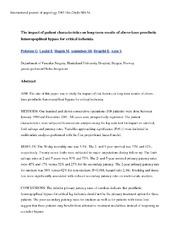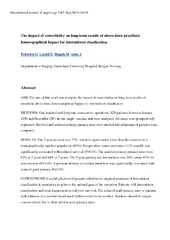| dc.description.abstract | Purpose: The purpose of this study has been to investigate the results of above-knee prosthetic femoropopliteal bypass surgery and to identify risk factors for complications and graft failure. The influence of comorbidity, degree of chronic leg ischaemia, preoperative angiographic run-off score and intraoperative flow measurements on long-term results were investigated. Furthermore, local infections and the outcome of treating occluded prosthetic grafts were studied. Methods: Two-hundred-and-thirty-seven patients (156 men, 81 women) were subjected to 252 above-knee prosthetic femoropopliteal bypass operations at Haukeland University Hospital between Jan 1990 and Dec 2001. One hundred and forty-one graft implantations (129 patients) were done for intermittent claudication and 111 (108 patients) for critical ischaemia. Patient data were prospectively recorded in a database registry. Some data were supplemented from patients records. Occlusion dates, complications, re-operations including amputations, and mortality were also recorded. Patient characteristics, anatomical risk factors and intraoperative flow measurements were analysed for impact on results after surgery. Survival, limb salvage and patency rates were analysed with the Product limit method and illustrated as Kaplan-Meier curves. The risk factors were subjected to univariate analysis using the log rank test for impact on survival, limb salvage and patency rates. Variables approaching significance were included in multivariate analysis performed with the Cox proportional hazard model. Results: Paper I. Surgical site infection was recorded after 7.8 % of the operations and graft infection after 12 %. The risk of developing a local infection was significantly correlated with postoperative lymph fistula. Redo surgery was associated with graft infection. Graft infections caused by Staph. Aur. always warranted surgery, either local revision or graft excision. Paper II. For grafts implanted for intermittent claudication, the assisted primary patency rates were 62 % at 2 years and 44 % at 5 years. The 5-year patency rate for smokers was 24 % versus 67 % for non-smokers (p < 0.01). A previous history of cerebral infarction was significantly associated with reduced graft patency. Preoperative s-creatinine > 125 mmol/L was significantly associated with reduced survival. Paper III. The 30-day mortality rate of patients operated for critical ischaemia was 5.5 %. The 2- and 5-year survival was 72 % and 42 %, whereas the limb salvage rates at 2 and 5 years were 83 % and 73 %, respectively. The 2-year primary patency rate for smokers was 38 % versus 62 % for non-smokers (p = 0.018, hazard ratio 2.18). Smoking and tissue loss were significantly associated with reduced secondary patency. Paper IV. Basal flow measurements were not related to patency. The 2- and 5-year patency rates for grafts with a papaverine flow < 500 ml/min were 48 % and 18 % compared with 66 % and 52 % for grafts with a papaverine flow ≥ 500 ml/min (p = 0.012, hazard ratio 2.6). Two and 5-year patency rates for smokers vs non-smokers were 44 % and 18 % vs 69 % and 54 %. Smoking (p = 0.008, hazard ratio 2.38) and poor run-off score (p = 0.009, hazard ratio 2.38) were independent risk factors for reduced patency. Poor run-off score did not correlate with low values of measured basal or papaverine flow. Paper V. Half the 24 initial procedures to restore patency of occluded grafts originally implanted for critical ischaemia failed within a month. Outcome of second or third-time redo procedures were similar. Primary patency rates of all 55 redo procedures were 32 % at three months, 28 % at six months and 12 % at 12 months. The results of thrombectomy and thrombolysis were similar. Re-opened grafts additionally treated for an underlying anastomotic stenosis had significantly better patency, as compared with re-opened grafts without a pre-existing stenosis (p = 0.027, hazard ratio 2.813). Conclusions: The results regarding survival, limb salvage and patency are comparable to previous reports. The results underline that a long observation period is necessary to achieve full overview of complications and the impact of risk factors. Infectious complications after prosthetic femoropopliteal bypass in the study group were higher than previously reported. The results suggest that a selective approach should be taken towards excision of infected femoropopliteal prostheses according to the clinical presentation of the graft infection and the type of bacteriae involved. A conservative attitude is recommended towards placing a prosthetic graft in the above-knee femoropopliteal position for intermittent claudication. The finding of reduced patency rates in patients with a history of a cerebral insult operated for intermittent claudication need further studies to be verified. Patients with intermittent claudication and renal impairment reveal poor survival, indicating renal impairment as a relative contraindication for surgical treatment. Smokers have inferior patency rates when operated for intermittent claudication as well as for critical ischaemia. Poor angiographic run-off score was also associated with inferior patency rates. These findings indicate that prosthetic femoropopliteal bypass is not very suitable for these groups of patients. Furthermore, the poor secondary patency rates of smokers as well as for patients with tissue loss suggest that these patients may benefit from alternative treatment modalities to re-opening an occluded bypass. A papaverine flow of < 500 ml/min is associated with reduced patency. Additional antithrombotic medication and frequent follow-up may be considered for these grafts. Redo procedures for occluded grafts originally implanted for critical ischaemia are of limited value and cannot be recommended except in cases with a proven graft-related stenosis. Other cases in need of re-intervention should be treated with either a new arterial reconstruction or an amputation. Based on the findings in this study, the following issues must be evaluated when offering an above-knee prosthetic femoropopliteal bypass for chronic limb ischaemia: patient comorbidity, smoking, degree of ischaemia and angiographic runoff score. Careful selection of patients subjected to above-knee prosthetic bypass surgery for chronic ischaemia is mandatory to achieve the optimal gain of the operation. | en_US |





